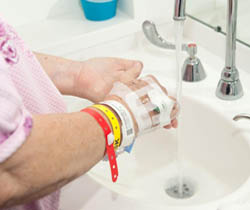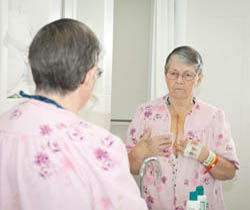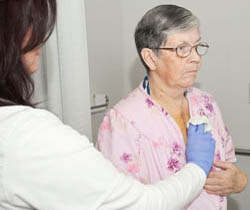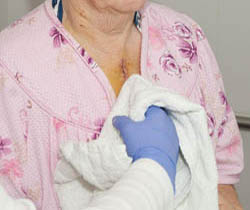How to care for your incision
How to care for your incision
The type of incision you have depends on the type of heart surgery you had:
- If you had a traditional sternal incision, your surgeon used sternal wires to close your breastbone, and your chest incision was closed with internal or external stitches.
- If you had minimally invasive surgery, you likely have a much smaller incision that may or may not have gone through your sternum.
You may also have small incisions on your groin, leg or arm, as well as small wounds from chest tubes, pacemaker wires or intravenous (IV) lines.
Inspect all your incisions and wounds every day for signs of infection.
Call your doctor or our Heart, Vascular & Thoracic Institute post discharge nurse line if you see:
- Increased drainage or oozing from the incision.
- Increased opening of the incision line.
- Redness around the incision.
- Warmth along the incision line.
- Fever (greater than 101 degrees Fahrenheit or 38.4 degrees Celsius).
- If you have diabetes and your blood sugar levels begin to vary more than usual.
Wash your hands before and after caring for or touching your incision.
Keep your incision(s) clean and dry
You do not need to cover your wound with a bandage unless there is drainage. If you have drainage, it is important to call your doctor.
Showering and Bathing
If your chest incision is healing and there is no drainage – it is ok to take a quick shower (no longer than 10 minutes).
If you have stitches in your chest, during the first two weeks after surgery, shower with your back to the shower spray. It is okay for your incision to get wet, but the shower spray should not directly hit your chest.
If you do not have a shower, you may take a quick bath (no longer than 10 minutes). Do not soak in the tub. The water temperature should be warm — not too hot or cold. Extreme water temperatures can cause you to feel faint.
It is ok to wash your incision when you shower or bathe, however only use soap and water to cleanse the site.
- Use normal bar soap, not perfumed soap or body wash. Don’t try a new brand of soap during your recovery.
- Place soapy water on your hand or washcloth and gently wash your incision(s) using an up-and-down motion.
- Do not apply ointments, oils, salves or dressings to your incision unless specifically told to do so.
- Pat the skin gently to dry.
For more information: See your Guide to Cardiac Surgery binder. If you have any questions or concerns, please call the Heart, Vascular & Thoracic Institute Post Discharge Phone Line at the number you were provided or your doctor’s office.
This information is about care at Cleveland Clinic and may include instructions specific to Cleveland Clinic Heart, Vascular & Thoracic Institute patients only. Please consult your physician for information pertaining to your care.
A Step by Step approach
 |
1. Wash your hands before touching your incision. |
 |
2. Look in the mirror. Inspect your incision for redness, drainage or warmth. Incision should be healing; there should NOT be an increase in opening. |
 |
3. Wash your incision gently with soap and warm water using a clean wash cloth or your hand and light touch. |
 |
4. Pat dry gently with a clean towel. |
 |
5. You do not need to cover your incision unless it is draining. If your incision is draining, wash your hands after touching your incision. |
Tips
- You can wash your incision daily.
- Call the doctor if you see signs of infection
- Increased drainage or oozing from the incision
- Increased opening of the incision line - there should not be gaps or pulling apart areas of the incision
- Redness along the incision - if the incision was red or pink when you left the hospital it should be improving not getting redder
- Warmth along the incision line
- Increased body temperature - greater than 101 degrees Fahrenheit or 38.4 degrees Celsius
- If you have diabetes and your blood sugar levels begin to vary